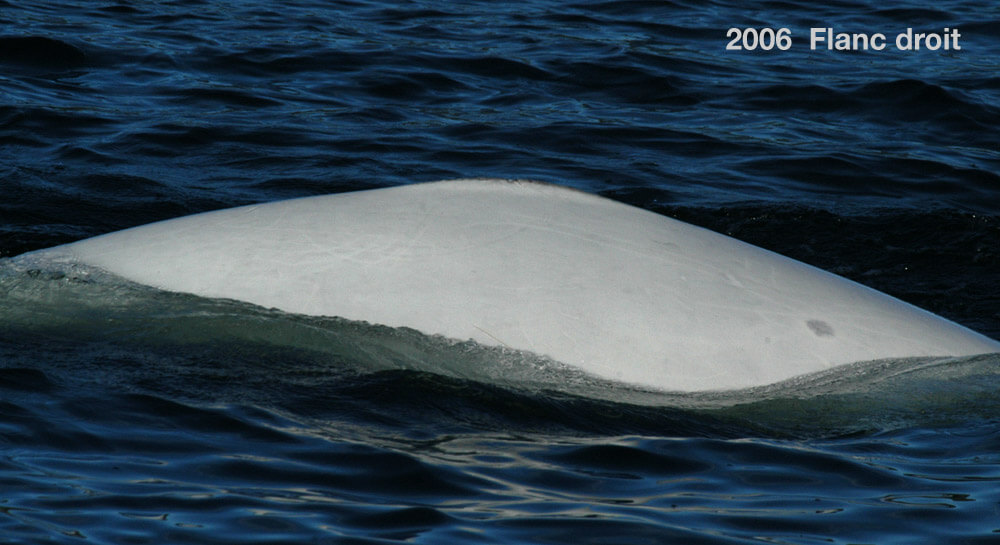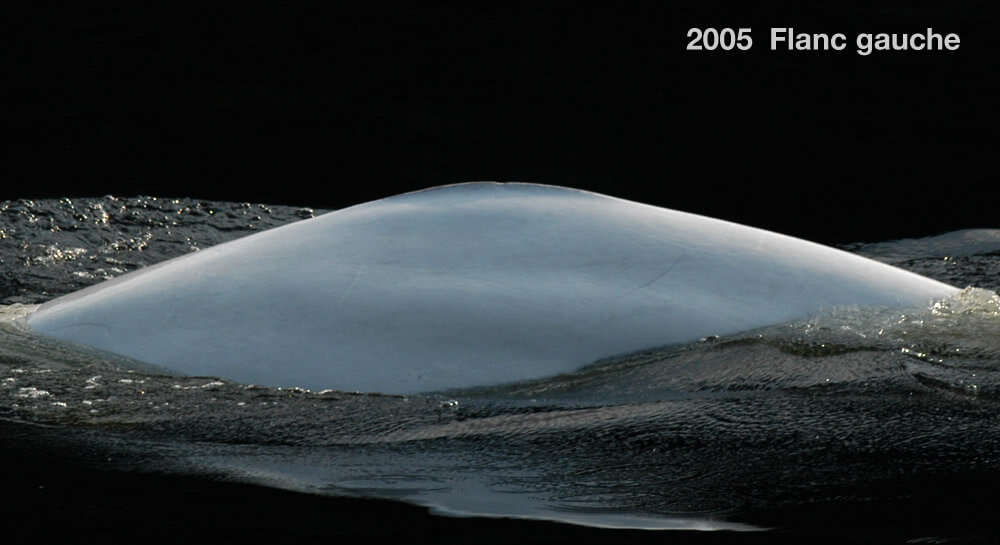Pacalou
Beluga


Adopted by Pascale Cauchi
-
ID number
DL1355
-
Sex
Female
-
Year of birth
Around 1992
-
Known Since
1997
Distinctive traits
Distinguishing Pacalou from the left flank only by the small indentations on her not very prominent dorsal crest is not easy. She’s best recognized by the round gray spot in front of the right flank crest.
Life history
We first met Pacalou in 1997. At the time, she was a young gray beluga aged four or five.
Pacalou is a female from the Saguenay community. Her sex was confirmed by a biopsy taken in the summer of 1998. In 2004, we regularly spotted her with her newborn son, Miss Frontenac.
Pacalou used to have two identities. When she first met GREMM, she was young, grey and dynamic. She was nicknamed Gonzo, but her name changed to Gonzesse after a biopsy the following year revealed her gender. As she grew older, her coloring became paler and the spot on her right flank darker. She was mistaken for a new beluga and named Pacalou… until the GREMM team compared Pacalou’s unique markings with those of the juvenile Gonzesse: identical!
Observations history in the Estuary
Years in which the animal was not observed Years in which the animal was observed
Latest news
On the Bleuvet, we welcome two new research assistants, Mathieu and Sophie. They are learning how to navigate and make gentle approaches to belugas for our research projects. Because every sea outing counts, we take the opportunity to do some photo-identification. We follow a herd of around twenty belugas as they head towards Ile Rouge, off the coast of Tadoussac. The camera snaps a portrait of Candy C and Pacalou. A few little grey belugas come to watch our boat, and our apprentice captains have to learn to navigate with caution. With the herd returned to Ile Rouge, one group heads back to Tadoussac, while another heads for Baie des Rochers. Another group starts to round the island towards Ile aux Basques. All groups swim gently towards their new destination.
On this autumn day, visibility is good and small waves are rippling the Saguenay. We’re near Anse Saint-Étienne, aboard the Bleuvet, GREMM’s research vessel. Surrounding us is a herd of 25 belugas, made up of adults, calves and a newborn calf. The herd is divided into three groups. In one of them, Blanchon is swimming with four other adults. Also in the herd are Dorothy, Pacalou and DL1508. The wind picks up and speeds up to 20 km/h. The beautiful little waves turn into sheep and the belugas start to dive longer. The time for observing the herd is over.
We observe Pacalou at the mouth of the fjord. She swims among a herd of 60 belugas. Among the herd are all-white individuals, including the females Miss Frontenac – Pacalou’s daughter – Neige and Pure Laine, as well as gray belugas. Four newborn calves can also be seen. The animals are scattered and very active. The dives are short-lived. We suspect they are feeding near the surface. The mouth of the Saguenay, with its particular oceanographic conditions, is rich in prey. In fact, two minke whales are also taking advantage of the abundance of food!
After an hour’s tracking, all the animals have headed upstream on the Saguenay. The fog begins to lift, and we leave them after snapping several shots.
Sponsor
Pascale Cauchi adopted Pacalou (2006).





